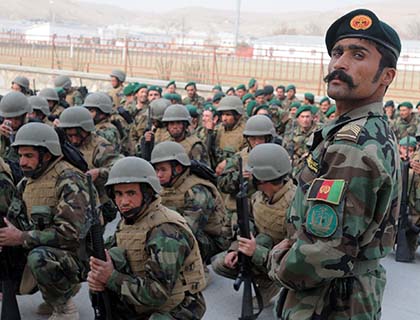According to some local newspapers, around 12 policemen, including a commander defected and joined Taliban militants in western Farah Province. They also took away a police vehicle, a tank and ammunitions, according to police officials in the province. Reportedly, the team was led by sergeant Mirwais, in-charge of three check posts. He joined to peace process years ago and got job in the police force.
Similarly, a man in the Afghan National Army uniform opened fire on foreign soldiers, injuring two of them in northern Farah province, on Monday. The ISAF media office in Kabul has also confirmed the incident, adding that the man was killed in retaliation fire. As usual Taliban accepted the responsibility and put the number of foreign casualties to four deaths.
A day before, on Sunday, in Herat Province, an individual wearing Afghan Nation Security force uniform turned his weapon against ISAF-contracted civilian employees and killed three of them.
Looking at this series of attacks and incidents, it is reasonable to worry about the future when there would not be strong and well-equipped foreign security forces anymore to challenge the notion of possible insurgents' resurgence. No matter how strong the international community tries to send message that it will not leave Afghanistan once again to mercy of the day, but instead will remain committed to its security, political stability and economic prosperity, but post-2014 will be period when Afghan government has to shoulder the security challenges alone.
Certainly, according to Washington officials, the United States will not pull its soldiers entirely out and there will be, perhaps, few thousand to train Afghan security forces, but what if Taliban infiltrators are not less among ANA and ANP?
The frequency and continuity of the attacks can reveal the harsh reality that Taliban sympathizers are not less among Afghan security establishments. Those who turn up and open fire against Afghan or foreign fellows, are indeed the core elements, who like suicide bombers, do not care about their lives.
Because they are certainly aware of the consequences of their attacks and likely understand that they wouldn't make out alive, but still they turn weapons and shoot their foreign fellows. Perhaps, the only thing always nudges their minds is that when to find opportunity to carry out attacks with maximum possible casualties.
Definitely, all militants are not ready to die for the cause; however, they all notice the possibility that anytime they might get killed, fighting Afghan Security forces and foreign allies. But if the situation alters in a way that dead becomes certain, only a minor stick to Mullah Omar and the rest of course defect. Those who remain they are the core and key player in the establishment, not of Taliban but of any organization.
When I am saying that those turn weapons against foreign security forces and understand that there is no hope for remaining alive, then they are the key elements as well as the real extremists who fight for mere ideology. Thus, simple sympathizers are distinguished from this portion of militants. The high frequency shows how remarkable number of Taliban main elements has infiltrated the government? Since January, around 20 of the so-called blue on green attacks are reported which have left 27 foreign soldiers dead. It is not clear how many others are on the line, seeking opportunity to turn their weapons and shoot foreign soldiers.
The situation looks more worrisome considering the idea I hinted in the above paragraph – 20 incidents in just seven past months? In some of those incidents more than one individual was involved. So, simply, it can be put that more than 20 militants' devoted elements were revealed to be Taliban infiltrators through targeting their fellows.
I do not know how many have failed to carry out their task and captured by their fellows or identified by intelligence agents. Thus, the number of those who turn against their fellows is considerably high. Additionally, the number of those who feel sympathy with Taliban and are not willing to fight against them is also high to a threatening level.
The question is how these sympathizers could have joined Afghan security forces? Previously, I have written about the issue and explained how the procedure of recruitment, nepotism, ethno-centrism and other forms of corruption have helped militants to easily get into.
Here once again I want to highlight that the very policy of communal representation and invisible hands of officials in the process of recruitment are the two main factors that pave way for infiltration. Since there is no accurate data about the percentage of ethnic groups, nobody can determine the percentage of each ethnic group in the power structure.
For example, only nine percent from Hazara community can be recruited in ANA. Annually thousands of people participate in military entrance exam and score quite well comparatively, but are rejected because, it is argued, percentage has already been completed.
Moreover, the ethnic sentiments still dominates the national sentiments. It has been a question for me how Taliban infiltrators remain unnoticed for a long time. It is possible that his fellows may identify him as sympathizers of Taliban but still avoid to report due to mere communal sentiment.
There are various solutions, but empowerment of intelligence is much favorable one. Yet militant failed to infiltrate within and it has remained somehow popular body within power structure. Thus, its empowerment can indeed do a lot in identification and detention of insurgents.

